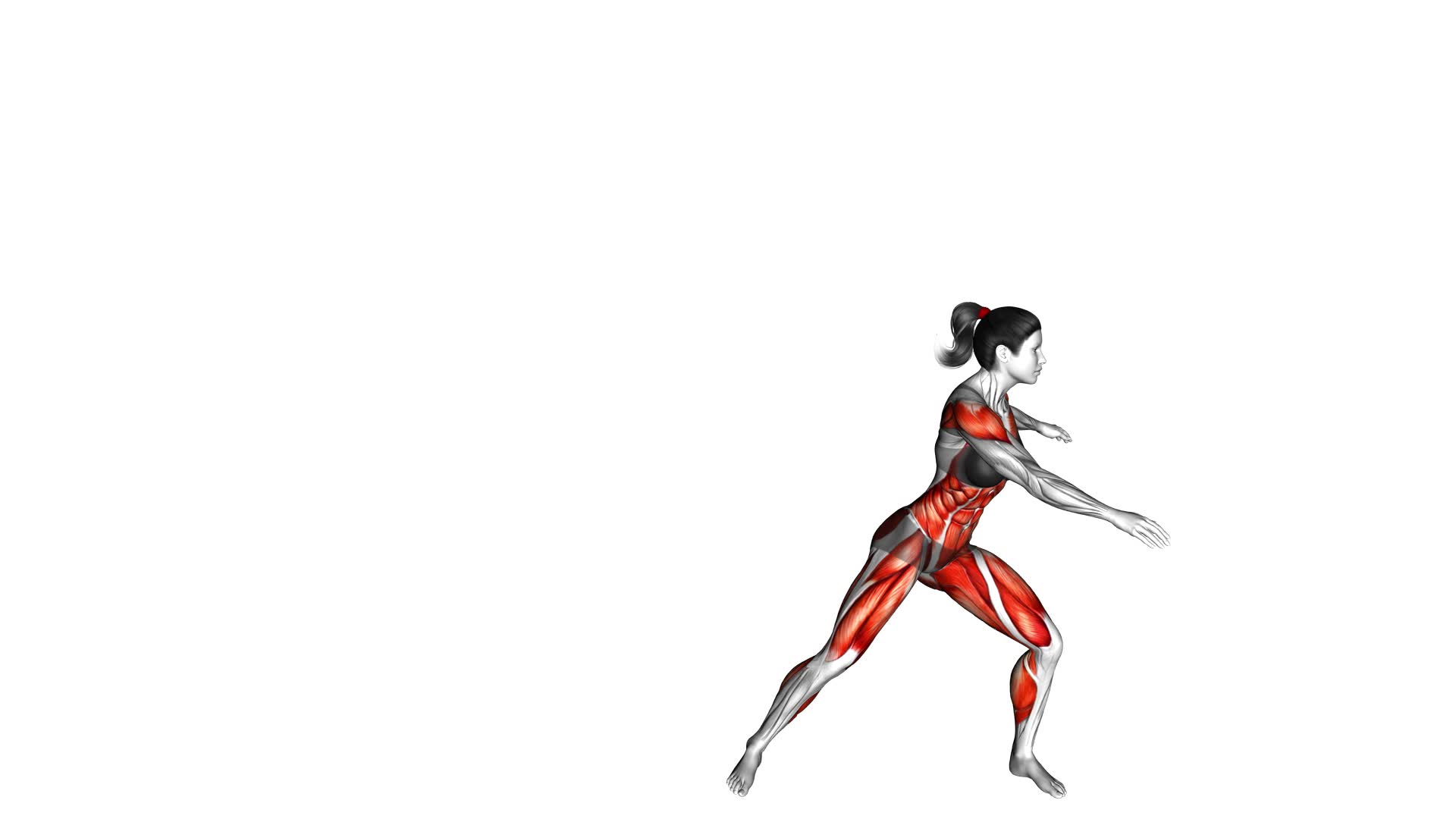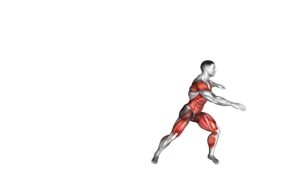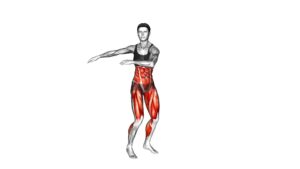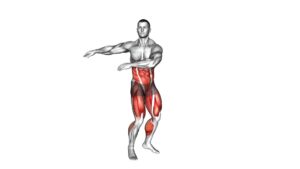Wind Side Twist Jump (female) – Video Exercise Guide & Tips

Are you looking for a dynamic and effective exercise to strengthen your core and improve your agility? Look no further than the Wind Side Twist Jump!
Watch This Exercise Video
In this video exercise guide, we'll show you the proper form and technique to maximize the benefits of this movement.
With modifications and progressions, you can tailor the workout to your fitness level.
Avoid common mistakes and get ready to feel the burn with this challenging yet rewarding exercise.
Key Takeaways
- The Wind Side Twist Jump is a beneficial exercise for increasing cardiovascular endurance and improving overall fitness level.
- This exercise engages the core muscles, including the obliques, transverse abdominis, and lower back muscles, while also boosting the heart rate and promoting fat burning.
- Proper form and technique are important, including keeping the feet shoulder-width apart, engaging the core muscles, and rotating the upper body while jumping.
- Common mistakes to avoid include twisting too forcefully, landing with locked knees, neglecting proper warm-up, and failing to focus on controlled movements.
Benefits of the Wind Side Twist Jump
One benefit of the Wind Side Twist Jump is that it increases your cardiovascular endurance and strengthens your core muscles. This exercise involves a dynamic movement that combines twisting and jumping, making it an effective way to improve your overall fitness level. By incorporating the Wind Side Twist Jump into your workout routine, you can expect to see improvements in your core strength and agility.
The twisting motion engages your obliques, transverse abdominis, and lower back muscles, resulting in improved core strength and stability. This not only enhances your performance in other exercises and physical activities but also helps to prevent injury. Additionally, the jumping component of the exercise increases your heart rate, boosting your cardiovascular endurance and promoting fat burning.
Furthermore, the Wind Side Twist Jump requires coordination and quick reflexes, which can lead to increased agility. This is beneficial in sports that require rapid changes in direction, such as basketball, soccer, and tennis. By regularly incorporating this exercise into your routine, you can enhance your ability to move quickly and efficiently, giving you a competitive edge.
In order to ensure that you perform the Wind Side Twist Jump correctly and effectively, it's essential to focus on proper form and technique. Transitioning into the subsequent section, we'll explore the key points to keep in mind to maximize the benefits of this exercise.
Proper Form and Technique
To perform the Wind Side Twist Jump correctly and effectively, focus on maintaining proper form and technique. Here are some key tips to ensure you execute this exercise with precision:
- Keep your feet shoulder-width apart: This will provide a stable base and help you maintain balance throughout the movement.
- Engage your core: A strong core is essential for this exercise as it will help stabilize your body and prevent unnecessary strain on your lower back.
- Rotate your upper body: As you jump, twist your torso to the side, keeping your arms extended and parallel to the ground. This movement targets your oblique muscles and adds an extra challenge to the exercise.
To avoid mistakes and get the most out of the Wind Side Twist Jump, be mindful of the following:
- Avoid using momentum: This exercise is about controlled movement, so resist the urge to rely on momentum to complete the twist. Focus on using your core and oblique muscles to initiate the rotation.
- Don't lock your knees: Keep a slight bend in your knees throughout the exercise to reduce the risk of injury and maintain proper form.
- Don't rush the movement: Take your time with each jump and twist, ensuring that you're maintaining proper alignment and engaging the correct muscles.
Modifications and Progressions
To further challenge yourself and continue progressing with the Wind Side Twist Jump, try incorporating modifications and variations into your routine. These modified movements can help you target different muscle groups and increase the intensity of your workout.
One modification you can try is the weighted twist jump. Instead of using just your body weight, hold a dumbbell or kettlebell in your hands and perform the twist jump. This added resistance will engage your core and upper body even more.
Another modification is the single-leg twist jump. Instead of jumping with both feet, perform the twist jump while balancing on one leg. This won't only challenge your balance and stability but also increase the activation of your leg muscles.
For those looking for advanced variations, you can try the double twist jump. This involves performing two twists in the air instead of one. This advanced variation requires greater core strength and coordination.
Additionally, you can incorporate a medicine ball into your routine. Hold the medicine ball in front of your chest while performing the twist jump to add an extra challenge to your workout.
Remember to always listen to your body and progress at your own pace. Start with the modifications that feel comfortable for you and gradually work your way up to the advanced variations.
Happy jumping!
Common Mistakes to Avoid
To ensure proper form and maximize the effectiveness of the Wind Side Twist Jump, it's important to be aware of common mistakes to avoid. By avoiding these mistakes, you can reduce the risk of injuries and improve your balance and coordination.
Here are three common mistakes to watch out for:
- Twisting too forcefully: While it's important to engage your core and twist your torso during the jump, avoid twisting too forcefully. Excessive twisting can strain your muscles and lead to injuries. Focus on controlled movements and gradually increase the intensity as you build strength.
- Landing with locked knees: When landing from the jump, it's crucial to maintain proper form. Avoid landing with locked knees, as this can put unnecessary strain on your joints. Instead, aim to land with a slight bend in your knees to absorb the impact and maintain stability.
- Neglecting proper warm-up: Before attempting the Wind Side Twist Jump, make sure to warm up your body properly. Warm-up exercises help increase blood flow to your muscles, improve flexibility, and reduce the risk of injuries. Incorporate dynamic stretches and light cardio exercises to prepare your body for the workout.
By being mindful of these common mistakes, you can perform the Wind Side Twist Jump safely and effectively.
Now, let's move on to the next section, where we'll discuss a sample workout routine incorporating the Wind Side Twist Jump.
Sample Workout Routine Incorporating the Wind Side Twist Jump
To effectively incorporate the Wind Side Twist Jump into your workout routine, begin by warming up your body and preparing it for the exercise. A proper warm-up is essential to prevent injuries and optimize performance. Start with some light cardio exercises such as jogging in place or jumping jacks to get your heart rate up and increase blood flow to your muscles. Next, perform dynamic stretches that target the muscles you'll be using during the Wind Side Twist Jump. Examples include leg swings, arm circles, and torso rotations.
Once you're warmed up, you can begin incorporating the Wind Side Twist Jump into your workout routine. This exercise can be performed in various workout variations to target different muscle groups and intensities. For example, you can add the Wind Side Twist Jump as a plyometric exercise in a circuit training routine. Perform 10-15 repetitions of the jump, followed by other exercises such as push-ups, squats, or lunges. Repeat the circuit for 2-3 sets.
Alternatively, you can incorporate the Wind Side Twist Jump into a high-intensity interval training (HIIT) workout. Perform the jump for 30 seconds, followed by 10 seconds of rest. Repeat this interval for 5-10 rounds. This will help improve your cardiovascular fitness and burn calories.
Remember to listen to your body and adjust the workout intensity and repetitions based on your fitness level. Always cool down and stretch after your workout to help prevent muscle soreness and promote flexibility.
Frequently Asked Questions
How Many Calories Can Be Burned by Performing the Wind Side Twist Jump?
When you perform the wind side twist jump, you can burn a significant amount of calories. The exact number of calories burned will depend on factors such as your body weight and workout duration.
However, this exercise is known to be a high-intensity movement that engages multiple muscles, making it an effective calorie-burning workout.
How Long Should a Beginner Start With When Incorporating the Wind Side Twist Jump Into Their Workout Routine?
As a beginner, it's important to start slow when adding the wind side twist jump to your workout routine. Begin by incorporating just a few repetitions of the exercise and gradually increase as you gain strength and confidence.
Remember to focus on proper form, keeping your core engaged and twisting from the waist. If you find the jump too challenging, you can modify by performing the exercise without the jump, focusing solely on the twisting motion.
Can the Wind Side Twist Jump Help Improve Balance and Coordination?
The wind side twist jump is a great exercise for improving agility, balance, and coordination. By incorporating plyometrics into your routine, you can reap the benefits of explosive movements and increased power.
This exercise challenges your body to quickly change directions and engage multiple muscle groups. It's an effective way to enhance your overall athleticism and boost your coordination skills.
Are There Any Specific Muscles Targeted by the Wind Side Twist Jump?
The wind side twist jump targets specific muscle groups, helping you build strength and tone in key areas. By engaging your core, glutes, and legs, this exercise improves stability and power.
Not only does it enhance your balance and coordination, but it also increases your overall athleticism. Incorporating the wind side twist jump into your routine can provide numerous benefits, making it a valuable addition to any workout regimen.
Can the Wind Side Twist Jump Be Performed by Individuals With Knee or Back Problems?
If you have knee or back problems, you may want to consider alternative exercises or modifications for the wind side twist jump. It's important to prioritize your safety and avoid any movements that may aggravate your condition.
Consult with a fitness professional who can guide you in finding suitable exercises that won't put unnecessary strain on your knees or back. Remember, there are plenty of other exercises that can provide similar benefits without risking injury.
Conclusion
Incorporating the Wind Side Twist Jump into your fitness routine can provide numerous benefits, including improved cardiovascular endurance, core strength, and coordination.
By maintaining proper form and technique, you can maximize the effectiveness of this exercise.
It's important to avoid common mistakes and progress at a pace that suits your fitness level.
Try incorporating the Wind Side Twist Jump into a sample workout routine to enhance your overall fitness and achieve your goals.

Author
Years ago, the spark of my life’s passion ignited in my mind the moment I stepped into the local gym for the first time. The inaugural bead of perspiration, the initial endeavor, the very first surge of endorphins, and a sense of pride that washed over me post-workout marked the beginning of my deep-seated interest in strength sports, fitness, and sports nutrition. This very curiosity blossomed rapidly into a profound fascination, propelling me to earn a Master’s degree in Physical Education from the Academy of Physical Education in Krakow, followed by a Sports Manager diploma from the Jagiellonian University. My journey of growth led me to gain more specialized qualifications, such as being a certified personal trainer with a focus on sports dietetics, a lifeguard, and an instructor for wellness and corrective gymnastics. Theoretical knowledge paired seamlessly with practical experience, reinforcing my belief that the transformation of individuals under my guidance was also a reflection of my personal growth. This belief holds true even today. Each day, I strive to push the boundaries and explore new realms. These realms gently elevate me to greater heights. The unique combination of passion for my field and the continuous quest for growth fuels my drive to break new ground.







